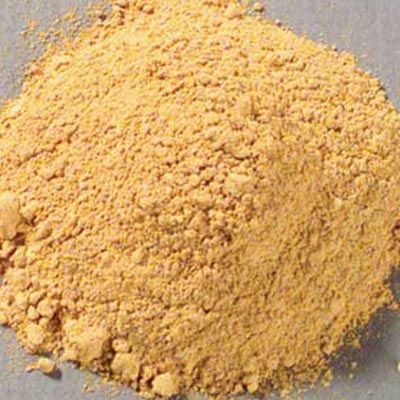Orpiment Pigment
A yellow arsenic sulfide, a rare mineral usually described as a lemon or canary yellow or sometimes as a golden or brownish yellow. Our orpiment is an intensely bright pigment of crystalline particles from Kyrgyzstan. Learn more.
WARNING! CONTAINS ARSENIC. Please read the SDS for cautionary statements.
Orpiment is yellow arsenic sulfide, usually described as a lemon or canary yellow or sometimes as a golden or brownish yellow. It is designated as brilliant yellow in Munsell notation 4.4Y 8.7/8.9. Our orpiment is made from natural mineral sources near Kadamdzhay in Kyrgyzstan or Hubei Province, China, and is an intensely bright pigment of crystalline particles.
| Pigment Names | |||||||
| Mineral Names: | Chinese: ci huang or shi huang (pinyin), tz'u huang or shih huang English: orpiment French: orpiment German: Rauschgelb, Operment Italian: orpimento Japanese: shiō, kiō, sekiō Russian: аурипигмент Spanish: oropimente | ||||||
| Artificial Pigment Names: | English: king's yellow French: juane royal, orpin artificiel German: Königsgelb Russian: желтый мышьяк | ||||||
| Synonyms: | English: arrhenicum, arsenic trisulfide, arsenikon, auripigment, auripigmento, auripigmentum, jalde, operment, oropiment, yellow arsenic French: arsenic jaune, arsenic sulfuré jaune German: Arsenblende, Arsenikon, Auripigment, Gelbe Arsenblende Greek: Αρρενικόν Αρδενικόν Latin: arsenicum flavum, auripigmentum | ||||||
| Nomenclature: |
| ||||||
Origin and History
It is a historical pigment identified on ancient Egyptian objects and paintings from the thirty-first to the sixth century B.C. It is mentioned in Greek and Roman literary sources. The Hellenistic Leyden papyrus described its use for late Egyptian painting, as does the Mappae Clavicula for early medieval painting. The pigment has been described in various other medieval manuscripts dating from the 12th to the 15th centuries.
Source
Orpiment is a rare mineral that usually forms with realgar. The two minerals are almost always together. Crystals of orpiment are extremely rare as it usually forms masses and crusts. The masses are sometimes transparent to a degree and have a gemmy quality to them. The yellow color is unique to orpiment and can be confused only with a few other minerals. Orpiment is derived from the Latin auripigmentum, or "golden pigment." The largest quantities of orpiment were found in Turkish Kurdistan (Julamerk) and the Republic of Georgia. The orpiment in Italian painting often came from the fumaroles of mount Vesuvius and the Campi Flegrei in Tuscany. Since the later Middle Ages, the pigment was also artificially made. This pigment would most likely result from the sublimation of arsenic, or arsenic oxide, and orpiment with and without the addition of sulfur. Notable occurrences of orpiment are found today in Kyrgyzstan; Romania; Peru; Japan; Utah, the USA; and Australia.
Permanence and Compatibility
Early authorities usually described orpiment as fading readily, or at least to some degree, on exposure to light. It is said to be incompatible with lead- or copper-containing pigments. Molart studied the mechanisms of deterioration in orpiment. Several medieval painting guides do not recommend mixing orpiment with lead white, red lead, or verdigris. However, it must also be noted that it has been identified in paintings mixed with indigo, red iron oxide, azurite, Prussian blue, green bice (artificial malachite), and bice (smalt). It cannot be applied to wet plaster and hence is not recommended in wet fresco painting techniques.
Oil Absorption and Grinding
No data has been published on the oil absorption properties of orpiment. It isn't easy to grind because of its micaceous structure. For this reason, it is often relatively coarse. Adding ground glass to the pigment has been suggested to facilitate grinding and dispersion in linseed oil.
Toxicity
The toxicity of arsenic sulfide pigments has been known for years. Extreme caution must be used when handling the dry orpiment pigment and in any soluble form to avoid inhaling the dust or ingesting it.

Pigment: Rublev Colours Orpiment
| Pigment Information | |
| Color: | Yellow |
| Colour Index: | Pigment Yellow 39 (77085, 77086) |
| Chemical Name: | Arsenic(III) Sulfide |
| Chemical Formula: | As2S3 |
| ASTM Lightfastness Rating | |
| Acrylic: | Not Rated |
| Oil: | Not Rated |
| Watercolor: | Not Rated |
| Properties | |
| Density: | 3.49 g/cm3 |
| Hardness (Mohs): | 1.5–2.0 |
| Refractive Index: | nα = 2.400 nβ = 2.810 nγ = 3.020 |



